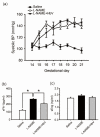Potential New Non-Invasive Therapy Using Artificial Oxygen Carriers for Pre-Eclampsia
- PMID: 28758949
- PMCID: PMC5618283
- DOI: 10.3390/jfb8030032
Potential New Non-Invasive Therapy Using Artificial Oxygen Carriers for Pre-Eclampsia
Abstract
The molecular mechanisms of pre-eclampsia are being increasingly clarified in animals and humans. With the uncovering of these mechanisms, preventive therapy strategies using chronic infusion of adrenomedullin, vascular endothelial growth factor-121 (VEGF-121), losartan, and sildenafil have been proposed to block narrow spiral artery formation in the placenta by suppressing related possible factors for pre-eclampsia. However, although such preventive treatments have been partly successful, they have failed in ameliorating fetal growth restriction and carry the risk of possible side-effects of drugs on pregnant mothers. In this study, we attempted to develop a new symptomatic treatment for pre-eclampsia by directly rescuing placental ischemia with artificial oxygen carriers (hemoglobin vesicles: HbV) since previous data indicate that placental ischemia/hypoxia may alone be sufficient to lead to pre-eclampsia through up-regulation of sFlt-1, one of the main candidate molecules for the cause of pre-eclampsia. Using a rat model, the present study demonstrated that a simple treatment using hemoglobin vesicles for placental ischemia rescues placental and fetal hypoxia, leading to appropriate fetal growth. The present study is the first to demonstrate hemoglobin vesicles successfully decreasing maternal plasma levels of sFlt-1 and ameliorating fetal growth restriction in the pre-eclampsia rat model (p < 0.05, one-way ANOVA). In future, chronic infusion of hemoglobin vesicles could be a potential effective and noninvasive therapy for delaying or even alleviating the need for Caesarean sections in pre-eclampsia.
Keywords: Keywords: pre-eclampsia; brain damage; fetus; hemoglobin vesicle; hypoxic condition; placenta.
Conflict of interest statement
The authors declare no conflict of interest
Figures





Similar articles
-
Artificial oxygen carriers rescue placental hypoxia and improve fetal development in the rat pre-eclampsia model.Sci Rep. 2015 Oct 16;5:15271. doi: 10.1038/srep15271. Sci Rep. 2015. PMID: 26471339 Free PMC article.
-
Placental expression of vascular endothelial growth factor in placentae from pregnancies complicated by pre-eclampsia and intrauterine growth restriction does not support placental hypoxia at delivery.Placenta. 1997 May;18(4):269-76. doi: 10.1016/s0143-4004(97)80061-6. Placenta. 1997. PMID: 9179920
-
Placental-specific sFLT-1: role in pre-eclamptic pathophysiology and its translational possibilities for clinical prediction and diagnosis.Mol Hum Reprod. 2017 Feb 10;23(2):69-78. doi: 10.1093/molehr/gaw077. Mol Hum Reprod. 2017. PMID: 27986932 Review.
-
Placental Growth Factor Administration Abolishes Placental Ischemia-Induced Hypertension.Hypertension. 2016 Apr;67(4):740-7. doi: 10.1161/HYPERTENSIONAHA.115.06783. Epub 2016 Feb 1. Hypertension. 2016. PMID: 26831193 Free PMC article.
-
Potential cell signalling mechanisms involved in differential placental angiogenesis in mild and severe pre-eclampsia.Curr Vasc Pharmacol. 2009 Oct;7(4):475-85. doi: 10.2174/157016109789043865. Curr Vasc Pharmacol. 2009. PMID: 19485894 Review.
Cited by
-
Placental vascular alterations are associated with early neurodevelopmental and pulmonary impairment in the rabbit fetal growth restriction model.Sci Rep. 2022 Nov 16;12(1):19720. doi: 10.1038/s41598-022-22895-6. Sci Rep. 2022. PMID: 36385147 Free PMC article.
-
Artificial oxygen carriers: a new future?Crit Care. 2018 Feb 23;22(1):46. doi: 10.1186/s13054-018-1949-5. Crit Care. 2018. PMID: 29471841 Free PMC article. No abstract available.
-
Artificial Blood: A Futuristic Dimension of Modern Day Transfusion Sciences.Cardiovasc Hematol Agents Med Chem. 2019;17(1):11-16. doi: 10.2174/1871525717666190617120045. Cardiovasc Hematol Agents Med Chem. 2019. PMID: 31204626 Free PMC article.
-
Nanomaterial-related hemoglobin-based oxygen carriers, with emphasis on liposome and nano-capsules, for biomedical applications: current status and future perspectives.J Nanobiotechnology. 2024 Jun 16;22(1):336. doi: 10.1186/s12951-024-02606-1. J Nanobiotechnology. 2024. PMID: 38880905 Free PMC article. Review.
References
-
- Sibai B., Dekker G., Kupferminc M. Pre-eclampsia. Lancet. 2005;365:785–799. - PubMed
-
- Bibbins-Domingo K., Grossman D.C., Curry S.J., Barry M.J., Davidson K.W., Doubeni C.A., Epling J.W., Kemper A.R., Krist A.H., Kurth A.E., et al. Screening for preeclampsia: US Preventive Services Task Force recommendation statement. JAMA. 2017;317:1661–1667. - PubMed
-
- Myatt L., Webster R.P. Vascular biology of preeclampsia. J. Thromb. Haemost. 2009;7:375–384. - PubMed
Publication types
LinkOut - more resources
Full Text Sources
Other Literature Sources

